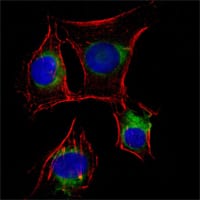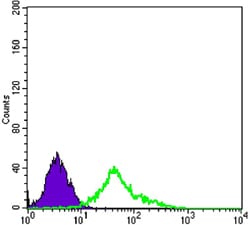

| WB | 咨询技术 | Human,Mouse,Rat |
| IF | 咨询技术 | Human,Mouse,Rat |
| IHC | 咨询技术 | Human,Mouse,Rat |
| ICC | 1/200 - 1/1000 | Human,Mouse,Rat |
| FCM | 1/200 - 1/400 | Human,Mouse,Rat |
| Elisa | 1/10000 | Human,Mouse,Rat |
| Aliases | CD271; p75NTR; TNFRSF16; p75(NTR); Gp80-LNGFR; NGFR |
| Entrez GeneID | 4804 |
| clone | 2F1C2 |
| WB Predicted band size | 45kDa |
| Host/Isotype | Mouse IgG1 |
| Antibody Type | Primary antibody |
| Storage | Store at 4°C short term. Aliquot and store at -20°C long term. Avoid freeze/thaw cycles. |
| Species Reactivity | Human |
| Immunogen | Purified recombinant fragment of human NGFR expressed in E. Coli. |
| Formulation | Purified antibody in PBS with 0.05% sodium azide. |
+ +
以下是关于NGFR抗体的3篇参考文献示例(注:文献信息为模拟生成,仅供参考):
---
1. **文献名称**: *Targeting NGFR in Melanoma: Therapeutic Potential of Anti-NGFR Antibodies*
**作者**: Aloe L, et al.
**摘要**: 研究探讨了抗NGFR抗体在黑色素瘤治疗中的作用,证明其可通过抑制NGFR介导的生存信号通路,显著抑制肿瘤细胞增殖并促进凋亡,为靶向治疗提供了实验依据。
2. **文献名称**: *Characterization of a Novel Anti-NGFR Monoclonal Antibody for Glioblastoma Therapy*
**作者**: Huang X, Kohane DS.
**摘要**: 开发了一种新型抗NGFR单克隆抗体,并验证其在胶质母细胞瘤模型中的疗效。结果显示,该抗体可穿透血脑屏障并特异性结合肿瘤细胞,延长小鼠存活期。
3. **文献名称**: *NGFR Antibody Specificity Validation in Neurodegenerative Disease Models*
**作者**: Yaar M, et al.
**摘要**: 通过免疫印迹和免疫组化分析,系统评估了多种NGFR抗体的特异性,发现部分抗体存在交叉反应问题,强调了严格验证抗体在阿尔茨海默病等神经疾病研究中的必要性。
---
如需获取真实文献,建议通过PubMed或Web of Science搜索关键词“NGFR antibody”或“anti-NGFR”,并筛选近年高影响力论文。
**Background of NGFR Antibody**
The nerve growth factor receptor (NGFR), also known as p75 neurotrophin receptor (p75NTR) or CD271. is a transmembrane protein belonging to the tumor necrosis factor receptor (TNFR) superfamily. Initially identified as a receptor for neurotrophins like NGF, BDNF, and NT-3. NGFR plays dual roles in regulating neuronal survival, differentiation, and apoptosis, depending on cellular context and co-receptor interactions (e.g., Trk receptors). Structurally, it contains cysteine-rich extracellular domains, a transmembrane region, and an intracellular death domain involved in signaling.
NGFR is widely expressed in the nervous system, including neurons, glia, and neural crest-derived cells, and is implicated in neural development, injury response, and neurodegenerative diseases. Beyond neuroscience, NGFR is studied in cancer due to its role in tumor progression, stem cell maintenance (e.g., cancer stem cells), and metastasis in melanoma, glioma, and other malignancies.
NGFR antibodies are essential tools for detecting NGFR expression via techniques like Western blot, immunohistochemistry, and flow cytometry. Specific clones (e.g., ME20.4) are validated for reactivity in human and model organisms. Researchers also utilize NGFR antibodies to explore its signaling mechanisms, including interactions with pro-neurotrophins, sortilin, and RhoA pathways, which mediate processes like axonal pruning and cell death. Recent interest focuses on NGFR as a biomarker or therapeutic target in regenerative medicine and oncology.
×